Honesty
This week: A long time ago; The stable wall; The hard work now starts!; Za Križen; Honesty; The simple pleasures;
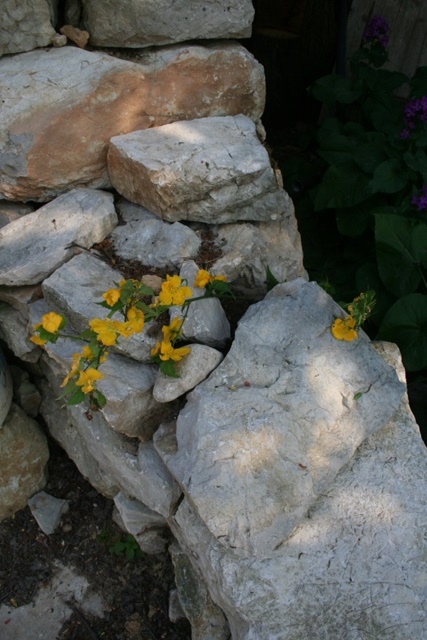
The temperature is accelerating towards 30ºC and all too soon the Tiger mosquitoes will be appearing from their winter hibernation.
But at the moment it is possible to spend the full day outside without having to lather insect repellent cream on every exposed piece of skin.
In a change to the advertised programme, it is just after 07:00 on Saturday morning. The sun has just appeared over the hills to the east and my study windows are open. Bird song fills the room with the distant sound of a donkey braying.
My usual Blog writing time is the afternoon and evening.
We are of course still under the lockdown restrictions being used to tackle the COVID-19 pandemic. But in all honesty, I haven’t changed my routine very much.
True, I have not been shopping for almost three weeks, but I have a full pantry and freezer. I did open my 4 week supplies box of staples at the end of the week.
How long will it go on for? Well I think I will have emptied my emergency supplies before the restrictions are lifted.
We had another case of the virus confirmed on the south side of the island, in someone who has come from the mainland. But with an almost complete ban on movement, the spread should be minimal. We do need everyone to follow the rules though.
A long time ago
When I joined the police service in the early 1970’s, it was possible to rent an unused garage at a police station for your private car. Where I was based, an oversized village, behind the police station there were four garages which had once been for the traffic patrol cars.
I have hunted for some photographs of the building but can only find one, and a poor one at that, but it will give you an idea of what the place looked like. Sadly it has been flattened and turned into housing.
The building had actually been the stables and trap house for the Superintendent. Up until the end of WWI, the mode of transport for senior police officers had been horses.
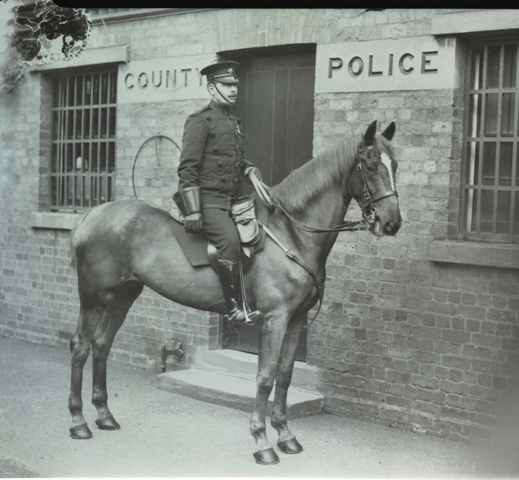
Every large rural station had stables and somewhere to keep the Superintendent’s trap.
Upstairs there was a large hay loft and a Constable Groom’s quarters which consisted of two rooms. One living and sleeping room with a large old fashioned kitchen range fire place and a tiny bathroom, with a door through to the hay loft.
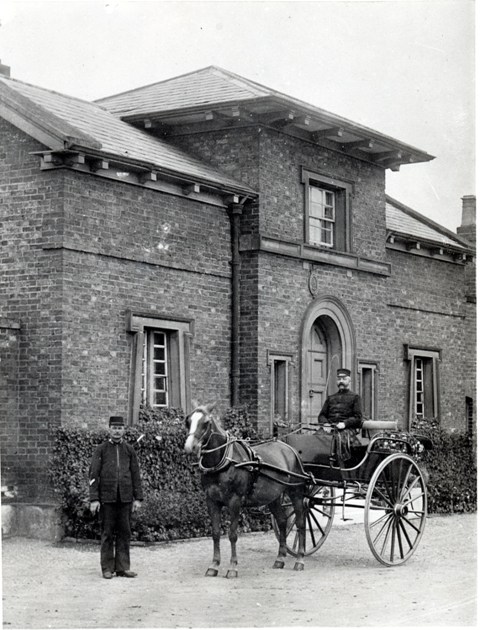
Down stairs there were three stalls and a loose box for horses. Inspectors in those days had a horse too, but only Superintendents had traps.
By the 1930’s the horses had gone but cars were now available, so the building was re-purposed to garages. When the horses went, so did the Constable Groom.

In the photograph the upstairs window was the bathroom. The large door opened into the hay loft. The trap house and tack room are on the right, and the stables, converted to a garage, are on the left.
This was a time when there was great emphasis in the police on Road Safety. The hay loft became a workshop for creating posters and displays to promote road safety and accident prevention.
By the time I joined, those involved had long since retired, but the workshop remained. As I was also involved in police public relations and displays, I started using the workshop, as well as the garage below.
When I was given responsibility for the force museum, I converted the building into a museum store. Hardly ideal, but better than nothing.
Electric wiring had been installed in the 1920’s but had never been upgraded, so what I was using for lighting and power was the same as my predecessors had been using for the previous 60 or so years.
In due course I found more suitable premises for a force museum store and everything was moved. The Magistrates Clerks wanted storage space for their records. The court was attached to the police station too.
One of the last things I removed was the original work lamp which had been fixed to the wall over the work bench upstairs in the hay loft. I also saved the metal racks which had held the horse bridles and tack.
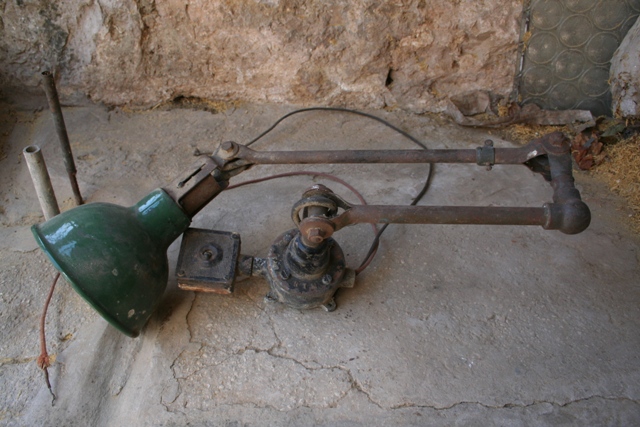
Some years later I found that the lamp had been thrown away because it wasn’t of sufficient historic interest.
Nowhere was it stamped “police” or “East Riding Constabulary“, a qualification for keeping artefacts. So I rescued it from the waste bin.
Since then it has travelled around the world with me, waiting for a permanent home.
The stable wall
When I moved into my Dol house, the stable was still in place, there was a thick bed of ancient straw.

There was lots of muck but the last occupants had left.
The people who were living here until just before I moved in had kept rabbits in the old stable. The straw went to start my compost heap.

In the local dialect, donkeys are called Konja. They are revered as the beast of burden which helped the local population through their hours of need.
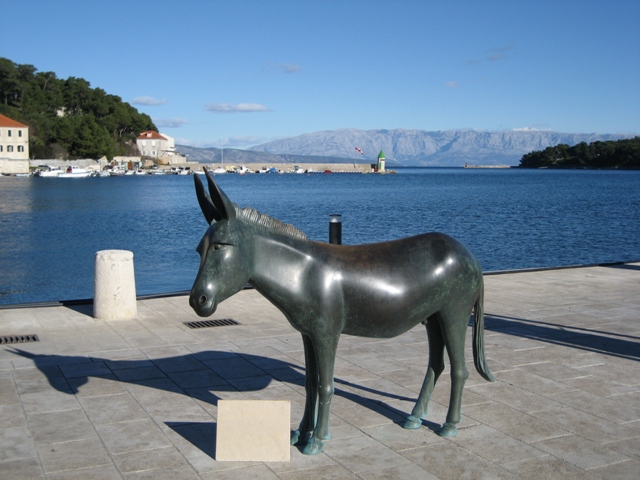
Every home had one or more and my neighbour Mario recently showed me the blanket, saddle and pannier frame that he still keeps in his store.

In my new building the old stone wall which was in the stable has been cleaned. The three large cubby holes are where the roof beams were slotted into the walls. They are staying.
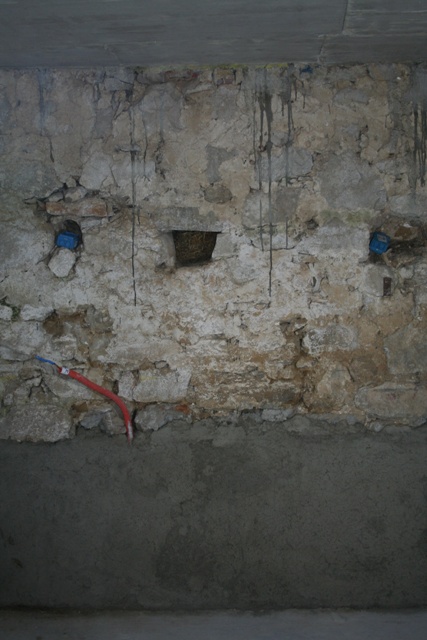
I carefully cleared out lime mortar from between stones, then fed electric cables into place. There is a ring main and also a lighting circuit.
The European wiring regulations IEC60364 CENELEC (European Committee for Electrotechnical Standardisation) require that lighting is protected by 5 amp fuse devices.
The sockets are on a separate circuit, protected by fuse devices of different amperage, according to usage. I’m following the 17th edition of the regulations exactly.
So there are separate feeds for ceiling lights and one running to the perfectly square stone between the two middle cubby holes. On to this stone I decided to mount the old police workshop lamp, after I have completely refurbished it.
I dismantled it easily because in the 1920’s things were well made. Every screw and bolt is made of brass, no nothing has corroded.

The light shade had been hard enamelled, so the inside will clean easily. Outside the green paint is dull, but still visible.
As Cvjetko said, it looks as though it has come straight out of an FBI interrogation at Alcatraz!
A little bit of work with a wire brush and the wall casing was cleaned of the years of accumulated grime.
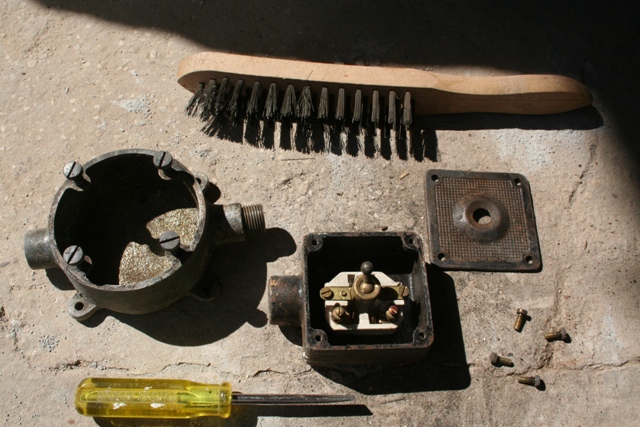
I sprayed them with an undercoat and corrosion inhibitor, before giving them a coat of mat black paint.
Holding the cases up to the wall, I carefully marked, then checked where I needed to drill the holes in the stone, for the wall plugs.
Drilling them carefully with a 4 mm then an 8 mm diameter SDS bit made sure that I didn’t damage the stone. However this particular block is a shale and several pieces around the holes flaked away.
I carefully fixed the pattress boxes in place and then made the connection to the lighting circuit (not yet live). I have also added a couple of enhancements.
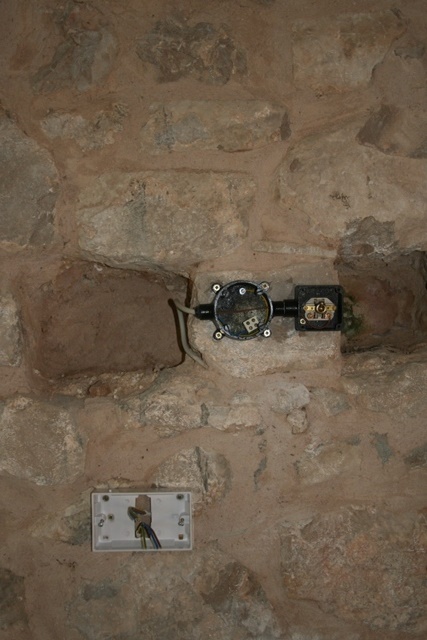
In the 1920’s, there was no earth connection required for lights. When I took the unit apart, the old two core cable was just three strand aluminium wire, in a rubber sheath, a red for live and a black for neutral.
I added an earth mounting bolt, so as I attached the modern 1.5 mm, three core lighting cable, there was somewhere to connect the earth lead to the metal casing.
While I was upgrading to 2020 standard, I also added a rubber grommet onto the incoming power cable, so insects can’t get into the cases.
The switch is a very nice brass unit, so while everything was in pieces, I polished the switch toggle with SOLVOL metal polish.
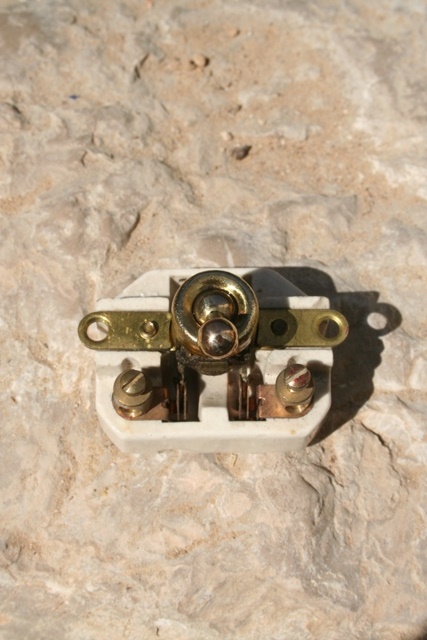
Finally I sprayed on a coat of lacquer to stop the brass oxidising.
Very few people will ever see it, or even notice, but I was always taught that “If a job is worth doing, it’s worth doing well”.
The hard work now starts!
After a marathon effort this week, the inside of the workshop has been finished.

The walls have now received their top layer of render and have been brushed with a wet sponge to give a nice textured surface.

At tea time on Wednesday, it was formally handed over to me for completion.
I think I need a separate list just for the things that now need to be done, starting with removing the moulding lines in the concrete ceiling.
Everything, ceiling, walls and floor needs painting, together with one wooden window.
All the electrical outlets need to be wired, then tested and only when all that has been done can I think of starting to move shelving, tools and equipment into the space.
I have made a start on making the new workshop doors this week. Using on-line ordering, I had arranged a delivery of timber from Volat, together with 10 litres of paint and hardware I had ordered.
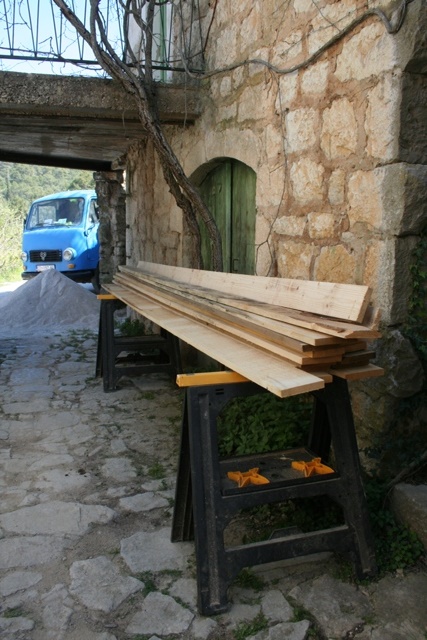
I am using a mix of old and new techniques. The actual doors will be made of two yellow 2 meter x 50 cm solid core boards.
These are inexpensive, extremely well made of properly seasoned timber, so there is no warping or shrinking. But I will then add ledges and braces.
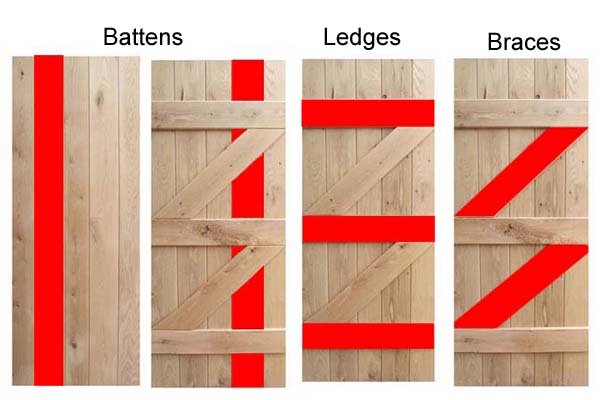
The wooden door panels really don’t need ledging and bracing as they are solidly made. But because of the width of the door, I will have to join two panels together so I will add ledges and braces to increase structural strength.
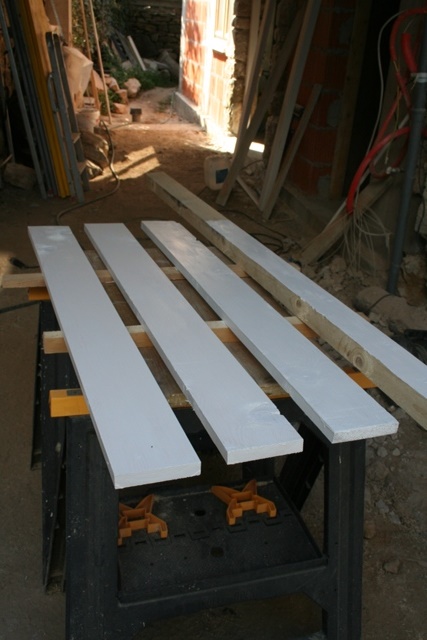
I cut the panels this week, then did a trial fit. They may need one or two millimetres removing, but it is a lot easier to remove a couple of millimetres, than try and stick two back on!
Then I became involved in some other essential work, so the door will be finished next week.
Za Križen
UNESCO is one of those under rated United Nations agencies. The organisation is critically important in the preservation of world heritage sites.
The list of UNESCO sites is broken down by Country and also into types of World Heritage. Here in Croatia there are ten physical UNESCO sites and we have one here on the island, the Stari Grad Plain
UNESCO also lists Intangible Cultural Heritage too. We are lucky because here on the island we have five: there is Lace making, the Mediterranean Diet, Dry Stone Walling, Klapa singing and the Easter procession of Za Križen.
At precisely 22:00 on Maunday Thursday, the barefoot Cross Bearers from the villages of Jelsa, Vrboska, Vrbanj, Pitve, Vrisnik and Svirče leave their parish churches to start the 25 kilometre circuit. This is the annual procession of Za Križen – literally “following the Cross“.
Each Cross visits the other five parish churches before returning to their home Parish, around dawn on Good Friday.
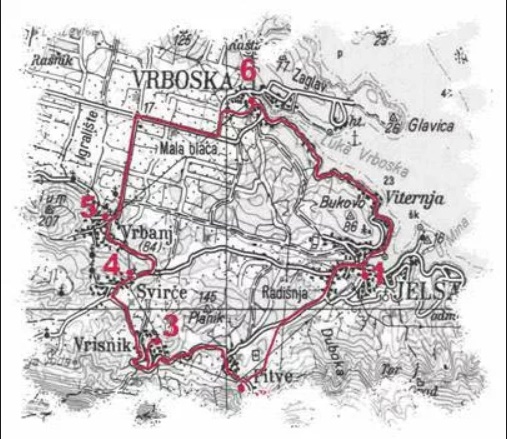
This year because of the COVID-19 restrictions, each of the six village processions was restricted to a maximum of 15 people. In fact most processions had fewer.
This is in contrast to processions in normal years where the pilgrims following each village cross number in thousands.
Throughout the journey, singers chant the Gospin plač, an octosyllabic ‘Passion text‘ from the 15th century. It is in the form of music and dialog sung without musical accompaniment, by villagers who are part of the procession.
There is a much smaller procession from Stari Grad to Dol, which takes place on Good Friday morning.
The fact that even with strict policing and vastly reduced numbers this annual procession was able to take place is good news. Perhaps by next year things will be back to a more normal state.
Honesty
I feel really bad about having neglecting parts of the orchards and garden.
As the days and nights have warmed significantly, I’ve removed the shade netting from around my young citrus trees. This has been in place since late November.
I’ve been rewarded with masses of flowers on the grapefruit, orange and lemon trees. Too many in fact. If some don’t self abort I will have to thin any fruit which forms into a sensible amount for the size of the trees.
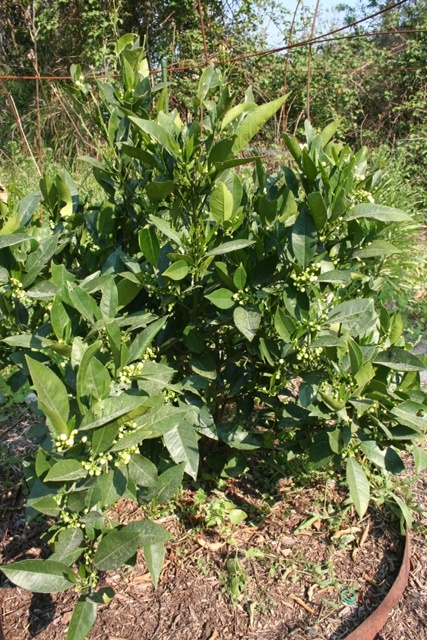
It’s surprising how something as simple as a wind break can make all the difference.

My Heath-Robinson frames and shade netting contraptions seems to have dome the trick.
Back on the 18th January (which seems a lifetime ago now) I reported on having taken four basal cuttings from a local Caper bush. These were put into my heated propagator.

Over the following weeks, one cutting died and I had to remove the leaves from the others because they were showing signs of mildew.
This week I am delighted to report that two of the three remaining cuttings have leaf buds growing, so at least 50% of my cuttings have survived and appear to have rooted.
The third looks as though it is still alive as well.
I will be looking after them, talking to them every day, as I do with all my plants, and allowing them to grow in pots before planting out into a suitable wall in the autumn. It’s another small success.
At the end of March last year, I planted some Honesty seeds. These came from my Mum’s garden in the UK.
I found a secluded, cool corner near the steps down into the orchard and put one row in to see what happened. They all grew.
Honesty, Lunaria annua, is a bi-annual. The plant germinates in its first year, then in the second year it flowers and in the same autumn turning to seed.
The seed pods are rice-paper thin translucent discs, hence the Latin name Lunaria – Moonlike. The seed pods remain in the second winter before the seeds fall out and grow where they fall.
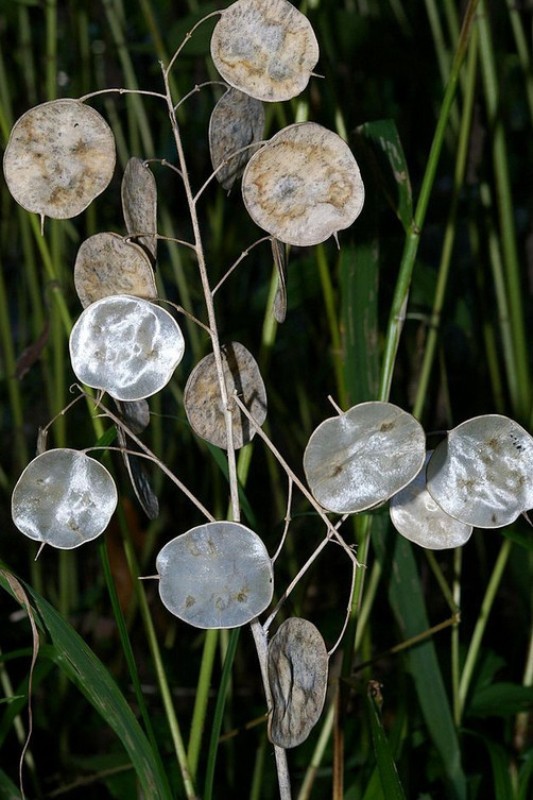
This week my Honesty plants have come into flower.
The purple blooms have brightened a rather dull corner and now I can look forward to a lot of seed pods this winter.
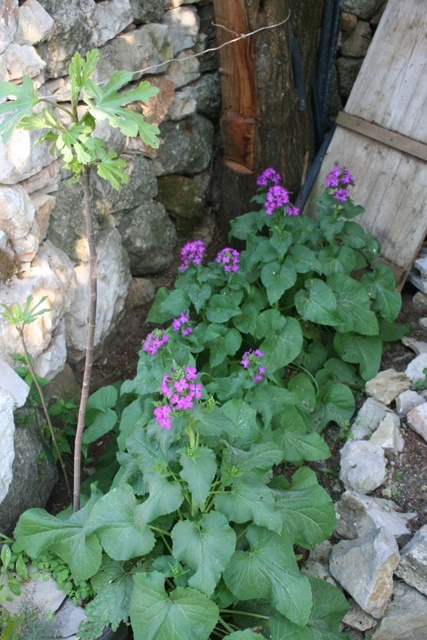
To make sure I have plants next year, I have put some more seeds in this week as well.
Although I have not set out to mix traditional English cottage garden plants with their Mediterranean cousins, this is what is happening before my eyes.
The simple pleasures
Last Sunday morning as I walked out onto the terrace, the sun was just coming over the roofline of my main building. The air was still and fragrant with the smell of dew on new foliage. Then I heard it.
From a tree at the far end of the orchard, there was the unmistakable song of a Nightingale. These dowdy little birds have a song like no other.

Although tiny birds, Nightingales migrate between Europe and tropical sub-Saharan Africa each spring and autumn, a round trip of more than 7,000 kilometres.

I have had a resident Nightinghale in one of my trees for the past three summers. This is a recording I made two years ago in the Top Orchard.
On Wednesday morning, I heard the unmistakable calls of a Swallow, then there were several. These migrants travel even further, between South Africa and Europe twice a year.
I wasn’t sure if it was a group of birds who were passing through on their way to their summer nesting sites, but by mid afternoon, they were still wheeling and calling above my Dol House. Much lower and clearly feeding on insects.
By Thursday, when they were still overhead, I knew they are my local residents.
With my new building, I now have several covered corners where they can build a secure nest from mud.
Growing up in York, we always had Swallows nesting in the rear porch. It would be really nice if a pair decided to build a nest and raise a brood somewhere in one of my cool, dark corners.
These are the simple pleasures of life. NRC
2 Responses
Brenda Fairfull
Lovely read, Norman. Stay safe in theses strange times.
Marcy
What a wonderful and exciting read. The pictures are amazing. Loved the procession and symbolism. Your flower pictures plus the pictures of the work building and it’s evolution are incredible. Thank you for sharing. Be safe.